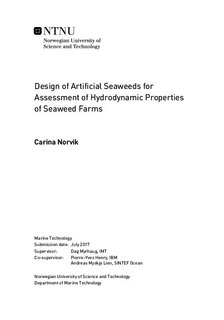| dc.description.abstract | In recent years the prospect of having a seaweed industry in Norway has become of interest. Assessing the hydrodynamic properties of seaweed farms through experiments can help optimize
its design and thereby potential amount of biomass produced. However, there are difficulties associated with using seaweeds for experimental purposes, such as deterioration of the biological material when exposed to environments different from where they were harvested. Moreover, many facilities do not allow for biological material to be introduced. Consequently, to be able to assess hydrodynamic properties of seaweed farms, artificial seaweeds that accurately replicate important features of seaweed biomechanics and hydrodynamics are needed. It is important that the these properties are correctly reproduced on both blade and patch scale.
The objective of this master thesis was to add to the knowledge of the hydrodynamics of seaweeds, more specifically Laminaria saccharina, the sugar kelp, to help future assessment of the hydrodynamic properties of seaweed farms. This was done by comparing drag force and behavior of two simplified blade morphologies, flat and undulate, both with uniform thickness. Even though seaweeds are subjected to both current and wave action, wave action was outside of the scope of this master thesis, and only steady, unidirectional flow was be considered. The experiments were conducted in the Marine Cybernetics laboratory at Department of Marine Technology at NTNU. The laboratory has equipment allowing for towing experiments. Two setups were use, one with only a profiled rod piercing the surface and one with a cylinder attached that allowed for dye to be distributed along its surface. The models were attached to the lower ends of the setups, and both blade and patch scale were considered. Two model sizes were tested for each simplified morphology. Due to high amounts of vibration and noise, the raw data was filtered before mean values and development of the drag force were presented. Underwater video footage allowed for some visual cues and behaviors to be observed and compared with the drag force.
The main finding of this master thesis, was that in contrary to the findings of Vettori (2016), flat blades do not seem to be a good representation of the undulate kelp L. saccharina. Agreeing with the findings of Paul and Henry (2014), it is likely that the models behave differently from the real seaweed due to different material density and therefore buoyancy. The reason for this conclusion can be seen from the video footage, showing that the models were behaving more similarly to a bending plant rather than a tensile plant at lower velocities. The Vogel exponent also had distinctly different behavior for the lower compared to higher velocities. These two regions of velocity could be found by looking at the angle between the flow and model. As L. saccharina has been shown to have near neutral buoyancy in water(Vettori, 2016), it is likely to behave as a tensile plant even at lower velocities, unlike the models tested.
From the findings in this master thesis, future development of an artificial seaweed model
for use as a surrogate of L. saccharina, should focus on models with undulate shape. Furthermore, to ease comparison with the hydrodynamic properties of the real seaweed, models should have the least amount of distorted parameters as possible. This to help uncover which parameters can be removed, and which are needed to correctly replicate important aspects of the seaweed hydrodynamics. In addition to looking at drag force, how the model influences the flow structure compared to the real seaweed should be examined. The reason for this being that oxygen and nutrient uptake are important factors to consider when optimizing seaweed farming. | |

